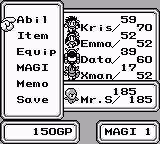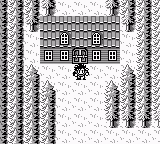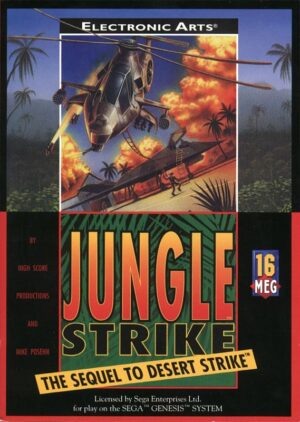Retro Replay Review
Gameplay
Final Fantasy Legend II refines the core mechanics of its predecessor by introducing a more nuanced class system and rewarding players for tailoring their combat style. At the outset, you select your protagonist’s race—Human, Monster, Mutant, or the new Robot class—each bringing distinct base stats and growth patterns. As you recruit additional party members, the interplay between these races and their unique abilities opens up a wealth of tactical possibilities, ensuring no two parties feel exactly the same.
(HEY YOU!! We hope you enjoy! We try not to run ads. So basically, this is a very expensive hobby running this site. Please consider joining us for updates, forums, and more. Network w/ us to make some cash or friends while retro gaming, and you can win some free retro games for posting. Okay, carry on 👍)
Building on the first game’s straightforward leveling, Final Fantasy Legend II adds an innovative twist: your chosen method of victory influences how your characters grow. Defeating foes with a sword boosts your Strength, while relying on spells bolsters your Mana pool. This system encourages experimentation, urging you to diversify your approach rather than relying on a single exploit. Suddenly, everyday random encounters become strategic puzzles in their own right.
Beyond combat mechanics, the game sprinkles in memorable side characters who join your party temporarily for key battles. These special allies often possess abilities unavailable elsewhere—whether it’s a healer whose Cure spells turn the tide at critical moments or a heavy-hitting warrior capable of clearing out swarms of weaker enemies. Their appearances feel organic to the unfolding narrative and keep encounters fresh, preventing the mid-game lull that often plagues other handheld RPGs.
Graphics
On the monochrome Game Boy screen, Final Fantasy Legend II achieves surprisingly expressive visuals. Character sprites are larger and more detailed than those in the original Legends game, granting each class a distinct silhouette. Whether you’re fielding hulking Robots or agile Mutants, it’s easy to identify who’s who in the heat of battle, which is vital when planning your next move.
The world map and dungeon layouts showcase improved tile work, weaving in thematic elements that hint at the story’s futuristic, planet-hopping scope. From craggy caverns to alien cityscapes, environments feel varied despite the hardware’s color limitations. Subtle shading and well-defined borders aid navigation, minimizing the frustration often associated with retro RPGs.
Battle animations, while simple by modern standards, carry weight through clever use of movement and timing. Sword swings arc convincingly, magic spells flash with a satisfying burst, and enemy sprites react dynamically, staggering or dissolving to emphasize your victory. Though pared-down, these visual flourishes heighten immersion and leave a lasting impression long after you’ve set the cartridge aside.
Story
While not as sprawling as later Final Fantasy epics, the narrative of Legend II deftly weaves exploration, science fiction, and personal growth. You begin as a lone adventurer searching for lost ruins, only to find yourself embroiled in a conflict that spans multiple planets. Along the way, you’ll uncover ancient technologies, clash with morally ambiguous foes, and make choices that underscore the bonds between your party members.
Dialogue is concise yet impactful, revealing characters’ motivations in just a few lines—a necessity on the Game Boy’s limited screen. Despite minimal exposition, the writing cleverly balances exposition with mystery, allowing players to piece together the lore at their own pace. Key plot twists unfold naturally during dungeon crawls and boss battles, keeping you invested in learning the fate of each world you visit.
The story also leverages its varied cast to explore themes of identity and purpose. Humans grapple with their mortality, Robots question their programmed directives, and Monsters ponder their place in an increasingly technologically advanced league. These narrative layers enrich otherwise routine RPG objectives, inviting you to care about your companions as much as your own progress.
Overall Experience
Final Fantasy Legend II stands out as one of the Game Boy’s finest RPGs thanks to its blend of strategic depth and accessible design. Its enhanced class system and experience mechanics encourage replayability; experimenting with different party compositions or alternate strategies never grows stale. Each journey through the solar system reveals fresh challenges and surprises.
Although modern players may balk at occasional random encounters and limited save points, the game’s pacing feels deliberate rather than punishing. Encounters serve as both tests of your party’s synergy and opportunities to fine-tune your approach, making every victory feel earned. Time-tested RPG conventions—inventory management, equipment upgrades, and side quests—are implemented with care, ensuring newcomers and series veterans alike find something to love.
In sum, Final Fantasy Legend II offers a robust, engaging adventure that holds up remarkably well decades after its release. Its thoughtful design choices, from class progression to narrative beats, deliver a satisfying package for fans of retro RPGs and newcomers seeking a challenging yet rewarding handheld experience. For anyone considering a deep dive into portable role-playing history, this title remains a standout choice.
 Retro Replay Retro Replay gaming reviews, news, emulation, geek stuff and more!
Retro Replay Retro Replay gaming reviews, news, emulation, geek stuff and more!









Reviews
There are no reviews yet.